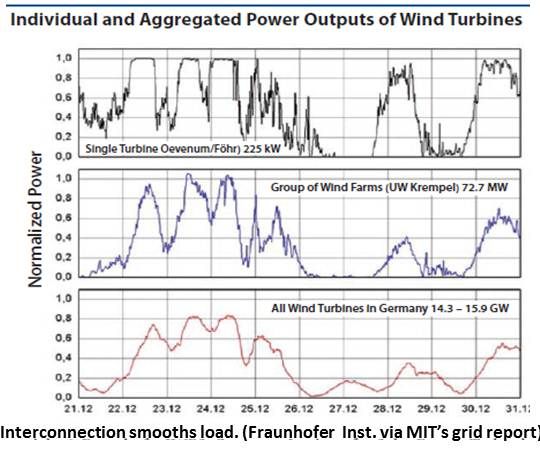The California transmission system operator is deftly managing a nearly 51,000-megawatt energy mix, one of the nation’s most robust, over some 25,000 circuit-miles of lines. That includes fourteen percent renewables. But Governor Brown wants 33 percent renewables by 2020.
Grid authorities who remember energy crisis-induced rolling outages or the 2003 East Coast blackout worry about politicians making decisions that affect the power delivery system. Building renewable capacity is challenging; building transmission capacity and grid operating systems is much more complicated.
The good news: A plan for wires is in place, according to California Independent System Operator Corporation (ISO) Director of Communications and Public Relations Stephanie McCorkle. “We will reassess annually, but at this point, we feel enough transmission has been approved by the ISO that we can get to that 33 percent,” she said. “The question is, of course, will it get built?”
Building new lines is difficult and time-consuming. “The regulatory process can vary from five to seven years and longer,” McCorkle said. “So just because it’s approved by the ISO doesn’t mean it’s going to be built when developers hope it will be built.”
The message: So far, so good.
But there is a lot more to integrating renewables than building new wires, according to ISO Director of Power System Technology Development Khaled Abdul-Rahman. He noted six further key points.

First, there has to be “adequate interconnection with your neighbors,” he explained. Interconnection with nearby markets makes renewables economically viable and softens variability.
Spanish wind’s potential to supply as much as half of its nation’s power, according to Abdul-Rahman, is hampered by inadequate interconnections with the EU market to which it could export more than three times as much wind as the present interconnection allows.
Abdul-Rahman’s second key point was that “a good market design that allows the balancing of energy to be done on multiple time scales, i.e., day-ahead, hour-ahead and real-time scheduling and dispatch.” The California ISO’s electronic marketplace is successfully doing that now. It has facilitated the integration of record levels of wind and solar this year. But as the proportion of renewables grows, the ISO’s market will need to get more capable.
That was Abdul-Rahman’s third key point. The system must have “advanced operational tools that assimilate variability and uncertainty” and “accurately forecast and reliably balance supply and demand.”
And fourth, there must be “system flexibility,” he said, which allows the system to quickly respond to any change in generation or load. The ISO’s Flexible-Ramp product, described in the second part of this series, will provide the flexibility to deal with balance issues if it has adequate “generation, demand and storage resources” to draw on.
Fifth, Abdul-Rahman said, “there should be new standards and rules for interconnecting to the grid requiring new variable resources to provide the support services that were traditionally only obtained from conventional synchronous generation units.” Such services prevent voltage instability that can cause system blackouts. “The technology is already available,” Abdul-Rahman said.
Finally, there must be clear rules governing interconnection. “The rules have to be applied to both conventional and renewables generators,” Abdul-Rahman said, “and you have to be clear from the beginning.”
Certainty is crucial, he explained, “so projects can secure their financing. Absent clarity, even if rules and technology are there, financing will still be difficult.” Without clear, long term rules, banks may be reluctant and slow to lend to developers. That, according to Abdul-Rahman, could make it hard for the ISO “to line up its transmission grid effectively.”
How much it will cost the people of California to make these changes remains undetermined. “Cost allocation studies are under way,” Abdul-Rahman said. “Some of the uncertainty is coming from renewables, some is due to anticipated load changes, some is coming from conventional generation, and some is coming from the transmission system itself.” The challenge is to allocate those costs accurately.

If the bulk of the cost is due to renewables’ uncertainty, the cost of their integration totals are high. If cost is allocated between all the factors that contribute to uncertainty, the cost of renewables integration is lower.
The same is true of new transmission. “If we are able to satisfy the renewables targets with existing transmission, there is no additional infrastructure cost,” Abdul-Rahman said. If new transmission is needed, that entails spending. But, he said, “one may argue that the rest of the system will also benefit from that transmission once it is built. So, that cost may not accurately represent the cost of renewable integration.”
Some grid experts are especially concerned with the costs and reliability threat from inadequate voltage regulation. Early wind and solar installations, unlike conventional generating units, lacked controls for voltage losses. Uncontrolled, downward spiraling voltage can lead to a cascading blackout.
Abdul-Rahman dismissed this concern. He said sophisticated power electronics built into today’s wind turbines and solar power plants provide the same voltage regulation services as conventional generating units. And because the capabilities are built into the generating units, they are part of the developer’s costs.
The ISO’s fundamental imperative is to facilitate the coming of renewables to the energy marketplace. The general tone of Abdul-Rahman’s remarks suggested he is confident the right kind of transmission that facilitates the right kind of marketplace can make that happen economically and reliably.



